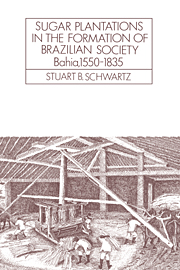Book contents
- Frontmatter
- Contents
- List of figures, maps, and tables
- Preface
- Abbreviations and special terms
- Weights and measures
- Dedication
- Part I Formations, 1500–1600
- Part II The Bahian engenhos and their world
- Part III Sugar society
- 9 A colonial slave society
- 10 The planters: masters of men and cane
- 11 The cane farmers
- 12 Wage workers in a slave economy
- 13 The Bahian slave population
- 14 The slave family and the limitations of slavery
- Part IV Reorientation and persistence, 1750–1835
- Appendixes
- Notes
- Glossary
- Sources and selected bibliography
- Sources of figures
- Index
- CAMBRIDGE LATIN AMERICAN STUDIES IN PRINT
12 - Wage workers in a slave economy
Published online by Cambridge University Press: 05 May 2010
- Frontmatter
- Contents
- List of figures, maps, and tables
- Preface
- Abbreviations and special terms
- Weights and measures
- Dedication
- Part I Formations, 1500–1600
- Part II The Bahian engenhos and their world
- Part III Sugar society
- 9 A colonial slave society
- 10 The planters: masters of men and cane
- 11 The cane farmers
- 12 Wage workers in a slave economy
- 13 The Bahian slave population
- 14 The slave family and the limitations of slavery
- Part IV Reorientation and persistence, 1750–1835
- Appendixes
- Notes
- Glossary
- Sources and selected bibliography
- Sources of figures
- Index
- CAMBRIDGE LATIN AMERICAN STUDIES IN PRINT
Summary
He who makes sugar, with reason they call master because his work demands intelligence, attention, and experience, not just any kind, but local experience.
André João Antonil (1711)Sugar making is given over to ignorance, and generally to stupid blacks who sing but have no measure, no rule, and no proportion.
Sampaio e Mello (1834)In the world of engenhos, mobility from field hand to proprietor, from slave to freedman, from those who labored to those who owned, or simply from black to white, was most apparent in the categories of wage earners that were always present in the sugar-making process. Although chattel labor characterized the sugar economy in Brazil from its inception until the end of the nineteenth century and slaves were always the predominant laborers, the nature of sugar production and its specific demands created a need for a body of wage earners at the core of the process. Field hands were almost always slaves, usually black, and predominantly Africans; senhores de engenho were invariably free and white; but in the intermediate positions of management, technical skill, and artisian craft were found freemen, freedmen, and slaves; whites, browns, and blacks. Here in the heart of the sugar economy was a sector of workers that by its very existence validated the system of slavery on which the industry was based by providing examples of mobility and advantage to those enslaved.
- Type
- Chapter
- Information
- Sugar Plantations in the Formation of Brazilian SocietyBahia, 1550–1835, pp. 313 - 337Publisher: Cambridge University PressPrint publication year: 1986



